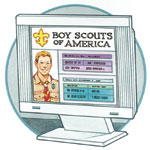
News Briefs
Monson named church leader
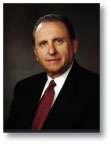 On Feb. 3, BSA Executive Board member Thomas S. Monson became the 16th president of the Church of Jesus Christ of Latter-day Saints.
On Feb. 3, BSA Executive Board member Thomas S. Monson became the 16th president of the Church of Jesus Christ of Latter-day Saints.
Born in 1927, Monson grew up in Salt Lake City, served in the U.S. Navy near the close of World War II, and graduated cum laude with a degree in business management from the University of Utah, which honored him in 1966 with a distinguished alumnus award.
Monson was ordained an apostle of the church in 1963 and rose through the ranks — most recently serving as First Counselor in the First Presidency of the Church.
Active in Salt Lake City community and civic affairs, Monson is a recipient of Scouting’s Silver Beaver Award and its Silver Buffalo Award. In 1993, he was awarded the World Scout Committee’s highest honor: the Bronze Wolf..
What’s Cooking? You Tell Us
Are you the Tyler Florence of the open flame? The Iron Chef of the iron-skillet spread? The Wolfgang Puck of the outdoor potluck?
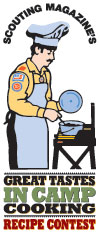 Or, do you just love camp-out cooking as much as we do?
Or, do you just love camp-out cooking as much as we do?
If so, enter our Great Tastes in Camp Cooking Contest for the opportunity to win prizes and share your favorite outdoor foods with Scouting magazine’s readers.
Our judges will select the top entries to receive gift certificates from the BSA Supply Division: Grand Prize ($400), 1st Place ($300), 2nd Place ($200), and 3rd Place ($100).
To win, you must certify that your recipe is either an original or a significant adaptation of another published recipe. And you have to field-test it in the great outdoors, too. The recipe should be cooked over a charcoal or wood fire, or by using a backpacking-style gas stove.
Only registered BSA adult volunteers can enter; BSA professionals and youth members are not eligible.
Categories include Entrée, Side Dish, and Dessert. You may submit up to three separate entries, but only one entry will be accepted per category.
Here’s how to enter:
Submit entries on, or format for, letter-size (8½ by 11 inches) paper and include (1) entrant’s name, address, daytime phone number, and unit number; (2) category entered; (3) name of dish and number of servings; (4) all ingredients with exact measurements; (5) complete directions for preparation.
Send entries by postal mail or electronically via the entry form on the Scouting magazine Web site. Entries must be postmarked no later than Oct. 1, 2008.
Mail your entries to Great Tastes in Camp Cooking Contest, Scouting Magazine, S304, 1325 W. Walnut Hill Ln., P.O. Box 152079, Irving, TX 75015-2079.
Check out the March-April 2009 issue of Scouting magazine to savor all the winning recipes.
Point, click, and shoot
 Grab your camera and go — then enter Venturing’s 10th Anniversary Photo Contest. Judges will choose winning images based on creativity, originality, visual beauty, and qualities that capture the essence of Venturing.
Grab your camera and go — then enter Venturing’s 10th Anniversary Photo Contest. Judges will choose winning images based on creativity, originality, visual beauty, and qualities that capture the essence of Venturing.
The contest features four categories: Spirit of Patriotism, Wildlife, People, and The Spirit of Venturing. Shoot your photos with a digital camera, using the camera’s highest setting, and then simply upload them directly online.
Submitted photos must include your name, address, daytime and evening phone numbers, unit number and position (if applicable), council name, and e-mail address. Contest rules allow up to three entries per person, and photos must contain the original images. Don’t enhance or alter them using software programs like Photoshop.
Officials will name a Grand Prize winner, as well as an individual winner in each of the categories. The Grand Prize winner and his or her parents will be awarded a three-day, all-expenses-paid trip to New York City to attend the annual meeting of The Explorers Club as guests of national Venturing Committee member and past club president Richard Wiese.
Well-known club members include former astronaut Neil Armstrong, oceanographer Robert Ballard, geologist Jim Fowler, and former test pilot Chuck Yeager.
The Grand Prize winner also will be awarded a $400 BSA Supply gift card, while winners in the four individual categories will each receive a $200 gift card.
Open to all registered youth members of the Venturing program, the contest’s deadline is Aug. 1. Winning entries will appear on the Venturing Web site. For more information and to enter your photos, log on to www.scouting.org/venturing.
James L. Tarr, 1919-2008
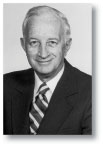 James (Jim) L. Tarr, 88, who served as Chief Scout Executive of the Boy Scouts of America from 1979 to 1984, died Feb. 27, 2008, in Dallas, Tex.
James (Jim) L. Tarr, 88, who served as Chief Scout Executive of the Boy Scouts of America from 1979 to 1984, died Feb. 27, 2008, in Dallas, Tex.
Born Nov. 21, 1919, in Bartlesville, Okla., Tarr joined the Boy Scouts in 1931 and earned the rank of Eagle Scout in 1935.
After graduating from what is now Oklahoma State University with a B.S. in business administration, Tarr began his professional Scouting career as a district executive in Austin, Tex., in June 1941.
He served in the U.S. Navy Reserve during World War II, attaining the rank of lieutenant commander.
Tarr returned to Scouting after the war as a district executive and later assistant Scout executive in Austin. From 1952 to 1964, his career also included stints as Scout executive in Galveston, Tex., Omaha, Neb., and for the Circle Ten Council in Dallas, covering North Central Texas and a portion of Oklahoma.
Named Chief Scout Executive in April 1979, he helped direct the move of the BSA’s national headquarters staff from North Brunswick, N.J., to Irving, Tex.
Tarr was named a Distinguished Eagle Scout in 1979 and received the Order of the Arrow Distinguished Service Award, the Cliff Dochterman Award from Rotary International, and a Bronze Wolf, the highest honor of the World Organization of the Scout Movement, awarded for exceptional service by the World Scout Committee.
Derby goes up, up, and away
Indiana racers went farther, faster, and higher at the Crossroads of America Council’s Pinewood Derby earlier this year.
Credit the track.
The tallest, longest one in the 55-year history of the derby, it measured two stories high and stretched 125 feet in length.
Built at the Indiana State Museum, located at White River State Park in downtown Indianapolis, the track evolved from a collaboration between the museum and the council, with technical assistance from local firms Ratio Architects Inc., F.A. Wilhelm Construction Company, and Associated Controls + Design.
“The idea for the track emerged from an exhibition titled ‘SPEED’,” says the museum’s marketing coordinator Michael Burrows. “The exhibit explained the physics of extreme motion — starting fast, moving fast, stopping fast.
“We have a good relationship with Scouting, so we thought why not wrap up the exhibit by holding the pinewood derby race here.
“Since the exhibit was about extreme speed, they said ‘Why just do a regular race? Let’s build the biggest track ever.’”
The competition features wooden cars, handcrafted and often custom designed, racing down an inclined track. The cars weigh less than 5 ounces and measure 2¾ inches wide by 7 inches long. Racers get three runs to achieve their fastest times. The Indiana races featured about 650 cars.
“Everyone thought it was really cool,” says Ryan Keys, activities and civic-service director at the Crossroads of America Council. “Some people brought their 30-year-old cars out to race.”
Whole families came and raced. The fastest car averaged 19 miles per hour, according to Burrows, which in terms of scale works out to about 475 m.p.h. “That’s pretty fast for a little block of wood that weighs so little and has no propulsion,” he says.
Although the museum dismantled the track after the race, it wasn’t destroyed.
“We’re planning to have the race again next year, shortly after New Year’s,” Keys says. “There’s even talk of making the track bigger, better, and faster. If not next year, maybe in 2010 to celebrate the BSA’s 100th anniversary.”
Lifeguard Training Revised
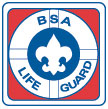 Learning how to save lives at BSA-operated facilities like summer camps just got a bit less complicated.
Learning how to save lives at BSA-operated facilities like summer camps just got a bit less complicated.
Over the past 25 years, the lifeguard program had grown to include many other specialized skills such as swimming, lifesaving, canoeing, rowing, first aid, and even spinal-injury management. It had become difficult for Scouting to meet the needs of both unit leaders and summer-camp lifeguards in a single course of doable length.
Now, though, the BSA Lifeguard program will focus solely on teaching the necessary requirements for professional lifeguards at BSA aquatic venues.
The basic skills presented closely match those of the revised training that the Red Cross introduced in 2007. However, the BSA’s program will feature operating procedures not offered in detail in the Red Cross course, including focus on specialized needs for waterfront facilities and clientele.
Approved by the National Health and Safety Committee and the National Program Committee, the BSA Lifeguard program is recommended for youth seeking positions on camp aquatic staffs and for unit leaders who want to expand their water-safety skills.
For unit leaders, two new Aquatics Supervision Programs, ”Swimming & Water Rescue” and “Paddle Craft Safety,” will provide the information and skills to support unit aquatics activities. A new “Aquatics Supervision” manual has been designed as the primary resource guide for unit aquatic activities.
Information about the prerequisites, requirements for training and course completion, and training and resource materials were scheduled to be posted on www.scouting.org in mid-April.
Cub Scouting revamps PTC courses
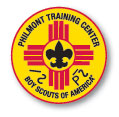 Much like kids, adults enjoy a diversity of experiences. That’s why the two weeklong training conferences for Cub Scout leaders this summer at the Philmont Training Center (PTC) near Cimarron, N.M., will feature more flexibility than in recent years.
Much like kids, adults enjoy a diversity of experiences. That’s why the two weeklong training conferences for Cub Scout leaders this summer at the Philmont Training Center (PTC) near Cimarron, N.M., will feature more flexibility than in recent years.
“Instead of putting people into one track and saying, ‘That’s where you will be the whole week,’ they’re going to be able to pick and choose,” says Jamie Shearer, associate national director of the Cub Scout Division.
In previous years, PTC course tracks for Cub Scouters focused on one’s job in Cub Scouting, like the “Strictly for Cubmasters” track.
This summer the Cub Scout Division will offer some of the best elements of past syllabi in the areas of camping, advancement, and training.
“Attention spans are much better when you keep doing different kinds of things,” says Rick Bragga, Philmont Training Center chair on the national Cub Scout Committee.
New this year:
- “Extra-special,” a category of general interest sessions that teach Scouters skills they can use in Cub Scouting and in life
- a daily keynote speaker
- “headliners,” speakers who make presentations in their areas of expertise.
During each of the two “Cub Scout Leader Extravaganza” weeks (June 22-28 and Aug. 10-16), a huge “share fair” will allow the Cub Scouters to share an example of what they do best with other participants.
Scouters interested in attending one of the sessions should contact their council’s Scout executive to obtain an invitation. Cost for the week is $420, with other age-specific programs available for a spouse and children who just want to spend a picturesque family vacation at Philmont Scout Ranch.
For more information on the PTC Cub Scouting conferences, check online at www.philmonttrainingcenter.org.
A leadership guide revised
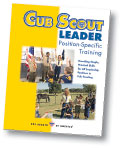 Find out how easy and fun Cub Scouting can be with the newly revised Cub Scout Leader Position-Specific Training guide. The guide offers exciting new features including a “see, say, and do” presentation with hands-on exercises that train leaders in skills such as running a den meeting, pack activities, and pack meetings.
Find out how easy and fun Cub Scouting can be with the newly revised Cub Scout Leader Position-Specific Training guide. The guide offers exciting new features including a “see, say, and do” presentation with hands-on exercises that train leaders in skills such as running a den meeting, pack activities, and pack meetings.
“Recognizing how valuable our Cub Scout volunteer’s time is today,” said Jamie Shearer, associate national director of the Cub Scout Division, “we’ve bundled all the skills necessary for a position into two 45-minute introductory modules that every leader will take and a separate 90-minute session
for each of the specific positions.”
Those positions include Tiger Cub leaders, Wolf and Bear den leaders and assistants, Webelos den leaders and assistants, Cubmasters and assistant Cubmasters, pack committee chairs and committee members, and pack trainers.
This revised training is one of four basic courses for new leaders; the others are Fast Start, Youth Protection, and New Leader Essentials. Fast Start acquaints new leaders with basic information about their position. Youth Protection guides leaders in protecting children from abuse and drug abuse. New Leader Essentials highlights the values, aims, history, funding, and methods of Scouting.
As of Jan. 1, 2008, the BSA requires Cub Scout leaders to complete each of these courses to earn the Trained emblem to wear on their uniform. Cub Scout Leader Specific Training is the only one of the four modules that is still instructor-led, giving attendees the opportunity to meet other leaders and learn about available resources.
The syllabus and support materials should be delivered to every district in each local council by this spring.
Real-life living and learning
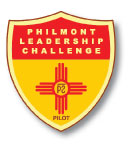 Learn the skills required to change the lives of others in the BSA’s new Philmont Leadership Challenge’s adult leadership training course. Taking place Sept. 21 to 27 at the Philmont Training Center in Cimarron, N.M., this pilot course allows participants to hone the skills they learned in Wood Badge for the 21st Century, combining elements of Philmont Ranger Training and advanced search-and-rescue exercises. The course is patterned on the National Advanced Youth Leadership Experience (NAYLE) course.
Learn the skills required to change the lives of others in the BSA’s new Philmont Leadership Challenge’s adult leadership training course. Taking place Sept. 21 to 27 at the Philmont Training Center in Cimarron, N.M., this pilot course allows participants to hone the skills they learned in Wood Badge for the 21st Century, combining elements of Philmont Ranger Training and advanced search-and-rescue exercises. The course is patterned on the National Advanced Youth Leadership Experience (NAYLE) course.
It’s an exciting weeklong backcountry experience that teaches “servant leadership,” ethical decision- making, and team-building skills through real-life situations and Leave No Trace guidelines.
Cost of the program, including meals, lodging, training materials, and a course patch, is $420. Make a $100 deposit along with your application and then pay the balance by June 1. For more information, check out www.philmontleadershipchallenge.org.